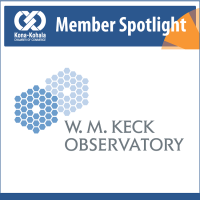Director Hilton Lewis to Step Down
Rich Matsuda to Serve as Interim Director
UC’s Bruce Macintosh and Caltech’s Lynne Hillenbrand to Co-chair Search Committee for New Director
Kamuela, Hawaiʻi, April 20, 2023 – The Board of Directors for the California Association for Research in Astronomy (CARA) today announced W. M. Keck Observatory Director Hilton Lewis will step down effective May 30, following a 37-year career in the design, construction, and operation of the facility and its twin 10-meter optical/infrared telescopes, including nine years as Director. Rich Matsuda, associate director of external relations for the Keck Observatory and interim member of the Maunakea Stewardship and Oversight Authority (MKSOA), will assume the position of interim Director while the Board conducts a global search.
“On behalf of the Board, I wou

ld like to thank Hilton for his many years of service,” said Chair George R. Blumenthal, chancellor emeritus, University of California Santa Cruz and director, University of California Berkeley Center for Studies in Higher Education. “We are most grateful that he dedicated his career to the advancement of the Keck Observatory, which achieved significant milestones in astronomy and astrophysics during Hilton’s tenure.”
During Lewis’ term as Director, the Keck Observatory led the world in research productivity, publishing more scientific papers per telescope than any other ground-based optical/infrared observatory. It also continued to enhance its adaptive optics (AO) capabilities to better compensate for blurring due to turbulence in the Earth’s atmosphere during this time. The Keck Observatory’s high-resolution imaging system is credited with enabling the discovery of a supermassive black hole – with the mass of four million suns – at the center of our galaxy, leading to a shared Nobel Prize in Physics in 2020.
Lewis oversaw the installation of a series of highly advanced new instruments atop Maunakea, including: the Near-Infrared Echellette Spectrograph, designed to obtain a full near-infrared spectrum of a faint object in one setting; the Keck Cosmic Web Imager, optimized for observations of faint, diffuse objects such as the intergalactic medium or cosmic web; and the Keck Planet Finder, which in November of last year achieved “first light,” capturing its first data from the sky and marking an exciting chapter in the search for Earth-sized planets around other stars.
“There is no one better to lead and steward the observatory through this transition than Rich,” Blumenthal said. “He will ensure Keck continues to be a leader in the field of astronomical research, delivering on its mission of enabling world-class discoveries.”
Over Matsuda’s 29-year career at the Keck Observatory, he was involved in the construction of the Keck II telescope and has served in a series of roles including as Chief of Operations, assuring the facility’s operatio
nal and organizational capacity to enable world-class science.
Last year, Matsuda was appointed by then-Governor Ige to serve as an interim member of the MKSOA, which will assume Maunakea governance and management responsibility from the University of Hawaiʻi following a five-year transition period. Matsuda served as a member of the Maunakea Working Group that ultimately recommended the formation of the MKSOA, calling for a new governance and management structure involving community-based mutual stewardship and Native Hawaiian decision-making. Born and raised in Hawaiʻi, he earned a bachelor’s degree in electrical engineering from University of Washington.
The Board’s Search Committee will be co-chaired by Director of the University of California (UC) Observatories Bruce Macintosh and by the California Institute of Technology’s (Caltech) Professor of Astronomy Lynne Hillenbrand. The search will commence immediately.
About CARA
CARA is a nonprofit corporation formed by the Caltech and UC to build and operate the W. M. Keck Observatory near the summit of Maunakea in Hawaiʻi. CARA is dedicated to advancing the frontiers of astronomy and sharing those discoveries with the world.
About W. M. Keck Observatory
The W. M. Keck Observatory telescopes are among the most scientifically productive on Earth. The two 10-meter optical/infrared telescopes atop Maunakea on the Island of Hawaiʻi feature a suite of advanced instruments including imagers, multi-object spectrographs, high-resolution spectrographs, integral-field spectrometers, and world-leading laser guide star adaptive optics systems. Keck Observatory is a private 501(c)3 nonprofit organization operated as a scientific partnership among the California Institute of Technology, the University of California, and the National Aeronautics and Space Administration (NASA). The Observatory was made possible by the generous financial support of the W. M. Keck Foundation.
 Director Hilton Lewis to Step Down
Director Hilton Lewis to Step Down ld like to thank Hilton for his many years of service,” said Chair George R. Blumenthal, chancellor emeritus, University of California Santa Cruz and director, University of California Berkeley Center for Studies in Higher Education. “We are most grateful that he dedicated his career to the advancement of the Keck Observatory, which achieved significant milestones in astronomy and astrophysics during Hilton’s tenure.”
ld like to thank Hilton for his many years of service,” said Chair George R. Blumenthal, chancellor emeritus, University of California Santa Cruz and director, University of California Berkeley Center for Studies in Higher Education. “We are most grateful that he dedicated his career to the advancement of the Keck Observatory, which achieved significant milestones in astronomy and astrophysics during Hilton’s tenure.”
-Horizontal-P301-w1920.png)
